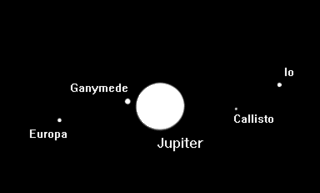
I had the pleasure of visiting the Griffith Observatory last night, which had its 72 year old 12" Zeiss telescope pointed toward Jupiter.
I got to see the Jovian planet and four of its moons - Io, Europa, Ganymede and Callisto. The sight looked a lot like this:
Except that I could actually see the creme and orange colored bands of Jupiter's cloud layers, which was pretty cool. (The Great Red Spot, unfortunately, had already rotated out of view.)
The image I saw through the telescope was not how Jupiter would have looked (from close range in space) at that moment, but how it would have looked (from close range in space) 45 minutes earlier, since its light takes 45 minutes to reach Earth.
Some other fun facts about Jupiter:
* Jupiter is two and a half times as massive as all of the other planets combined.
* Jupiter has a very faint planetary ring system.
* The orange and creme colored bands are cloud layers in Jupiter's atmosphere. They rotate in opposite directions; the resulting turbulence creates great storms (such as the Great Red Spot).
* Its largest moon, Ganymede, is bigger than the planet Mercury.
* Its fourth largest moon, Europa, may have oceans of water underneath its icy surface (and, therefore, may have extraterrestrial life as well). (Like Saturn's moon Enceladus.)
* Galileo discovered Jupiter's four largest moons in 1610, via his new and improved telescope. This was the first time anyone had actually observed satellites orbiting anything other than Earth, and his discovery cast major doubt on idea of an Earth-centered universe.
(He also used his telescope to discover that Venus went through phases, which proved Copernicus' earlier hypothesis that Venus, and the other planets, orbited the Sun. This observation got Galileo in trouble with the good ole Church and he was put under house arrest outside of Florence for the remaining years of his life.)
Last night was my first visit to the Observatory and it did not disappoint. If you live in So Cal, check it out. They're going to point that telescope toward Mars in a couple of months.
Monday, September 10, 2007
Now Showing at the Observatory: Jupiter and the Galilean moons
Subscribe to:
Post Comments (Atom)

2 comments:
The Griffith Observatory: Makes mom cry every time.
Everything: Makes your mom cry every time.
And I love it.
Post a Comment